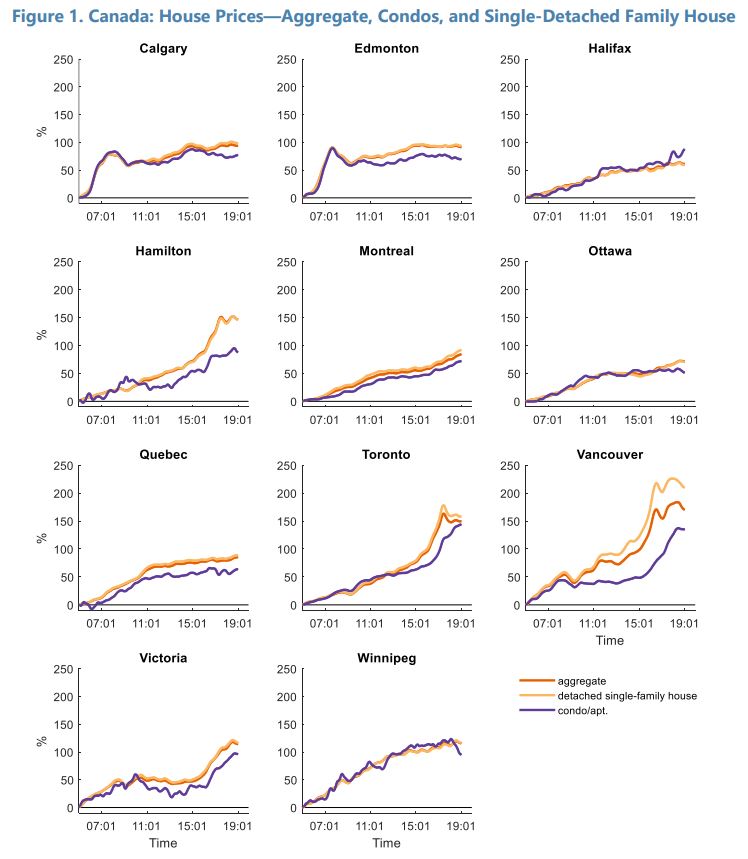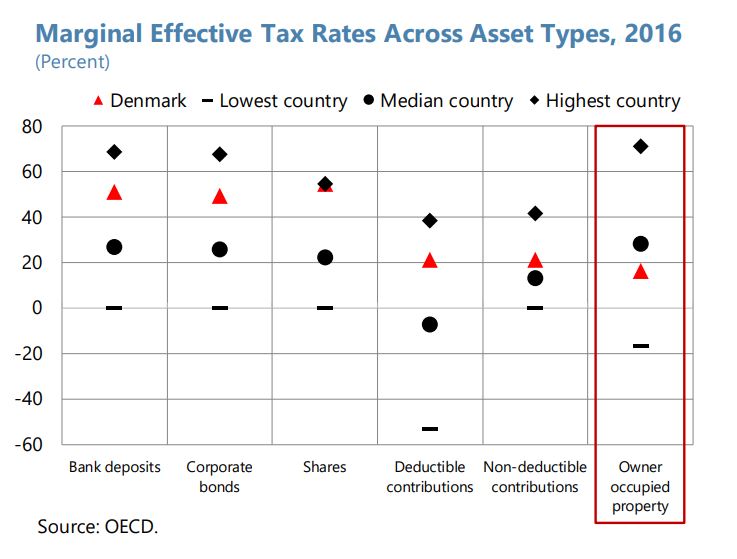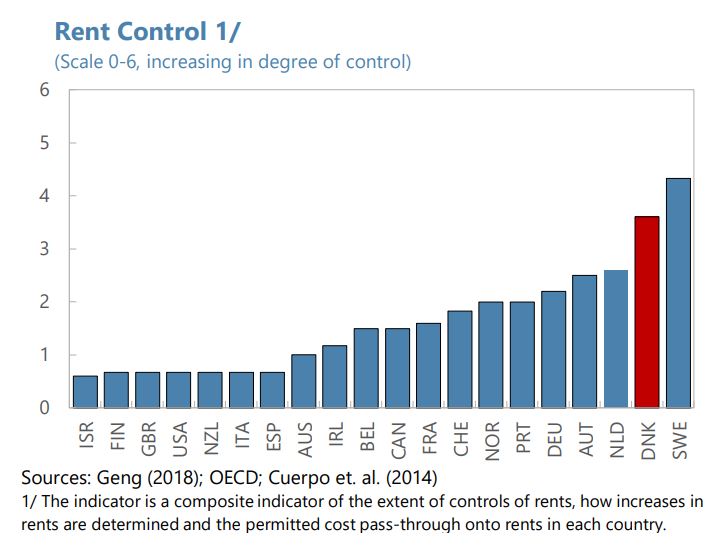Tuesday, June 25, 2019
Assessing House Prices in Canada
From the IMF’s latest report on Canada:
“House prices in most Canadian regions can be explained by economic fundamentals, but prices in Hamilton, Toronto, and Vancouver are currently well-above estimated attainable levels. Since 2000, house price developments in most metropolitan regions can be explained by robust income growth and a decline in mortgage interest rates. House prices have broadly increased in line with households’ borrowing capacity. However, since 2015, prices in Hamilton, Toronto, and Vancouver have deviated significantly from fundamentals. By the end of 2018, pricing gaps stood at around 50 percent for Toronto and Vancouver, and almost 60 percent for Hamilton.
The overvaluations currently observed in Hamilton, Toronto, and Vancouver are not unprecedented. In 2006, house prices in Calgary and Edmonton increased sharply above estimates of borrowing capacity. Pricing gaps normalized by 2012 due to a combination of moderate declines in house prices, strong household income growth, and a decline in interest rates. Looking ahead, housing markets in Hamilton, Toronto, and Vancouver are not likely to benefit from such significant declines in interest rates. This suggests that without very strong income growth, there is a risk of further price corrections in these markets.
Nationwide increases in price-to-income ratios have significantly lowered housing affordability. Declines in mortgage rates have generally been rapidly priced in by housing markets, increasing price-to-income and loan-to-income ratios. With rising price-to-income ratios, down payments have become larger, increasing the time it takes to save for a house, and adversely impacting housing affordability. While housing affordability has deteriorated in all of the regions examined, the deterioration has been most marked in Hamilton, Toronto, and Vancouver.
If house prices rapidly reflect households’ ability to borrow, even well-intentioned policies that improve access to credit are likely to increase house prices and adversely impact affordability. Policy measures that increase households’ capacity to borrow—such as increasing the mortgage loan amortization period or subsidizing loans—will likely put additional upward pressure on prices. Indeed, for such measures to work, the supply of housing would need to be exceptionally (and unrealistically) elastic, even in the short run. As such, policy measures focused on increasing housing supply are needed to durably improve housing affordability over the long term.”
From the IMF’s latest report on Canada:
“House prices in most Canadian regions can be explained by economic fundamentals, but prices in Hamilton, Toronto, and Vancouver are currently well-above estimated attainable levels. Since 2000, house price developments in most metropolitan regions can be explained by robust income growth and a decline in mortgage interest rates. House prices have broadly increased in line with households’ borrowing capacity. However, since 2015, prices in Hamilton,
Posted by at 3:51 PM
Labels: Global Housing Watch
U.S. Housing Market
From the IMF’s latest report on the United States:
- FSAP recommendation on housing finance: “Reinvigorate the momentum for comprehensive housing market reform”
- Developments: “Housing finance and the U.S. housing market have not been reformed comprehensively. Since the last FSAP, no legislative or executive action has been taken to reduce substantially the footprint of Fannie Mae and Freddie Mac (“Enterprises”).
As conservator, however, the (FHFA has required market-based credit risk transfers from the Enterprises to the private sector at an increasing level since 2013. Indeed, between their initiation in 2013 and June 2018, the Enterprises have transferred a portion of credit risk on approximately $2.5 trillion of unpaid principal balance (UPB) with a combined Risk in Force (RIF) of about $81 billion. The Enterprises have also jointly developed a common securitization platform. FHFA issued a final rule on the uniform mortgage-backed security in February 2019 to align Enterprise policies and practices that affect cash flows of To-Be-Announced (TBA) eligible mortgage-backed securities. These requirements apply to both the Enterprises’ current offerings and to the new Uniform Mortgage-Backed Security (UMBS), which the Enterprises plan to begin issuing in June 2019. These Enterprise reforms have been accomplished administratively and have not reformed the entire housing finance system, which would require legislative action.
Since 2015, the FHFA has directed the Enterprises to fund the Housing Trust Fund and Capital Magnet Funds (as required by the 2008 Housing and Economic Recovery Act) by transferring a portion of total new acquisitions to these funds, which are administered by the Department of Housing and Urban Development (HUD) and Treasury Department, respectively. FHFA has the discretion to suspend the Enterprise allocations to the affordable housing funds, including the Housing Trust Fund, if the allocations are contributing to the Enterprise’s financial instability.
The Senior Preferred Stock Purchase Agreements (PSPAs) between the Treasury and each Enterprise continue to provide financial strength for the Enterprises. They ensure the ability of the Enterprises to meet their financial obligations and are structured so that they will have minimal net worth as all profits above the capital reserve amount are transferred to Treasury each quarter. The capital reserve amount had been declining by $600 million per year and was scheduled to decline to zero by January 2018. However, on December 21, 2017, FHFA and the Department of the Treasury agreed to reinstate a $3 billion capital reserve amount for each Enterprise to prevent draws on the PSPA due to fluctuations in the Enterprises’ income due to the normal course of business. Despite the new capital reserve, the December 2017 tax cuts caused the Enterprises to draw a combined total of $4 billion at the end of that quarter, reflecting value loss in deferred tax assets that followed enactment of the Tax Cuts and Jobs Act of 2017.
In June 2018, FHFA issued a proposed rule on Enterprise capital requirements. The rule would implement a new framework for risk-based capital requirements and two alternatives for a revised minimum leverage capital requirement for the Enterprises. The capital requirements in this rule would continue to be suspended while the Enterprises remain in conservatorship.
On March 27, 2019, the White House issued a Presidential Memorandum on Federal Housing Finance Reform. The memorandum establishes principles for reform and assigns responsibility to the Secretaries of the Treasury and HUD to develop plans for administrative and legislative reforms for the Enterprises and the housing programs of the federal government. As part of the process, the Treasury Department and HUD are required to consult with the leaders of other government agencies involved in housing finance and economic policy, including FHFA, and must submit the plan to the President for approval.”
From the IMF’s latest report on the United States:
- FSAP recommendation on housing finance: “Reinvigorate the momentum for comprehensive housing market reform”
- Developments: “Housing finance and the U.S. housing market have not been reformed comprehensively. Since the last FSAP, no legislative or executive action has been taken to reduce substantially the footprint of Fannie Mae and Freddie Mac (“Enterprises”).
As conservator, however, the (FHFA has required market-based credit risk transfers from the Enterprises to the private sector at an increasing level since 2013.
Posted by at 11:33 AM
Labels: Global Housing Watch
Housing Market in Denmark
From IMF’s latest report on Denmark:
“The housing market plays a vital role in Denmark, reinforcing macro-financial linkages. High mandatory pension contributions and household savings have created a pension system that has facilitated the development of the world’s largest covered bond market in percent of GDP. Insurance companies, pension funds, and foreign investors are among the largest holders of covered bonds, which are issued by MCIs to fund household mortgages (…). Thus, housing asset exposures interlink MCIs, pension funds, insurance, foreign investors, and the household sector. Hence, shocks to real estate may impact negatively households’ financial and non-financial assets, hindering consumption; thus, reinforcing macro-financial linkages (SIP 2018).
High household leverage amid high house valuations remains a key source of macrofinancial vulnerability. High house prices, a favorable tax treatment, and easy access to low-cost borrowing incentivize the funding of housing with large mortgages. These factors explain why Danish households’ debt-to-income ratios are among the highest in advanced economies. Large liabilities are counterbalanced by large assets (housing and pension). However, high gross debt, combined with illiquid assets (concentrated in real estate) expose households to price and interest rate shocks that can impact asymmetrically their balance sheet. Two types of households appear particularly vulnerable. Households who have purchased in potentially overvalued urban areas (SIP 2018), where loan-to-income (LTI) ratios and credit growth are higher than anywhere else. And low-income households who spend a significant share of their income on housing. These vulnerabilities are compounded by the large proportion of variable-rate and interest-only mortgages in the system (…).
Recent developments are encouraging but further action is needed. Staff welcomes the comprehensive suite of policies that have been implemented in recent years. These include policies targeting households and financial intermediaries in the form of macroprudential policies (SIP 2018), supervisory guidance for MCIs and banks, and a reform of property taxation (IMF 2017). While overall house prices are softening and households are switching to loans with higher amortization and lower interest rate risk, staff advocates further deployment of coordinated policies to address remaining vulnerabilities.
Macroprudential instruments. In an economy with elevated house prices, rules targeting loan-to-value (LTVs) become less binding. Thus, increased focus on income-based measures, including debt-to-income (DTI), loan-to-income (LTI) and debt-service-to-income (DSTI) might prove more effective in addressing high leverage and encourage faster amortization. Staff welcomes rules implemented in 2018 to limit lending via interest-only and floating-rate mortgages to highly-indebted households.21 However, authorities could strengthen DTI restrictions for all loans, irrespective of their loan-to-value ratios. Tighter limits on income based measures for interest-only and adjustable-rate mortgages should also be considered, while calibrating limits to these measures for lower risk groups—first-time home buyers and low-levered households—and where financing is via fixed–rate mortgages.22 Highly-leveraged households—with debt-to-income above 400 percent—should be subject to mandatory amortization, irrespective of amortization periods (SIP 2018).
Macroprudential framework. A review of the efficacy of policy implementation is encouraged, including a review of institutional arrangements (…). The process followed by the SRC to arrive at a recommendation can take too long, potentially hindering implementation. Given that the decision-making power lies with the government, there is a risk that political considerations could delay the consensus process that tends to form the basis of such recommendations (FSAP 2014). Experience from other countries indicates that improvements in timeliness can be achieved by assigning independent authorities a macroprudential mandate which includes legal powers to implement macroprudential policy with corresponding transparency and accountability requirements.
Tax policy. Tax treatment of owneroccupied housing is very favorable compared to other savings vehicles and most OECD countries. MID should be reduced further, taking advantage of the current low rate environment. To incentivize homeowners to swap risky mortgages, MID could be made conditional on amortizing and/or fixed rate mortgages. Balancing tax incentives for pension contributions could release resources for larger down-payments; thereby reducing household leverage.
Housing supply. Rent controls in Denmark, among the highest in advanced economies, should be reduced to stimulate the rental market, while protecting the interest of the most vulnerable. Restrictions on the size of new apartments should be relaxed in urban areas to improve demand-supply mismatches. Upgrading of public transportation could relieve house price pressures around fast growing urban centers. Streamlined zoning and planning procedures across municipalities could increase supply, thereby alleviating price pressures.
Authorities agree that macro-financial risks stemming from the interaction between high household leverage and high house valuations should be followed closely. Authorities indicate that household resilience to interest rate increases likely improved as more homeowners continue shifting towards fixed rate mortgages and longer fixing periods. They also welcome the recent softening in apartment prices. The authorities argue that additional measures would require further analysis of the effects on the housing market and the overall economy. Authorities see the macroprudential framework as well functioning including the timeframe for the CCyB implementation and SRC’s independence. The DN notes that the long-term success of the framework depends on policy-makers’ continued implementation of the SRC’s recommendations.”
From IMF’s latest report on Denmark:
“The housing market plays a vital role in Denmark, reinforcing macro-financial linkages. High mandatory pension contributions and household savings have created a pension system that has facilitated the development of the world’s largest covered bond market in percent of GDP. Insurance companies, pension funds, and foreign investors are among the largest holders of covered bonds, which are issued by MCIs to fund household mortgages (…).
Posted by at 11:19 AM
Labels: Global Housing Watch
Friday, June 21, 2019
Housing View – June 21, 2019
On cross-country:
- Hot Property: The Housing Market in Major Cities – SpringerLink
- Q1 2019: Continued strong house price rises in Europe and Asia-Pacific, but globally housing markets are slowing – Global Property Guide
- Summer 2019 Issue – Real Estate Economics
- The Housing Cycle: What Role for Mortgage Market Development and Housing Finance? – Journal of Real Estate Finance & Economics
- Real estate: post-crisis boom draws to a close – Financial Times
- Investors Are Buying More of the U.S. Housing Market Than Ever Before – Wall Street Journal
On the US:
- Why Housing Policy Feels Like Generational Warfare – The Atlantic
- Cities Start to Question an American Ideal: A House With a Yard on Every Lot – New York Times
- Land Use Regulation and Housing Prices – University of Pennsylvania
- New York property barons lose grip on state politics – Financial Times
- Roy on Resegregation and Other Roots of the Housing Crisis – UCLA
- Will Fannie and Freddie get a new sibling? – MarketWatch
- Los Angeles Is in Crisis. So Why Isn’t It Building More Housing? – The Atlantic
- On Rent Subsidies and Affordable Housing – Wall Street Journal
- Is America Finally Waking Up to Its Government-Created Housing Crisis? – Reason
- Minimum Wage Still Can’t Pay for a Two-Bedroom Apartment Anywhere – Citylab
On other countries:
- [Australia] Understanding Rising Housing Loan Arrears – Reserve Bank of Australia
- [Ireland] ESRI urges more aggressive site tax to spur housing supply – The Irish Times
- [Lithuania] Lithuania’s modest house price rises – Global Property Guide
- [Mexico] Mexico’s housing market is strengthening – Global Property Guide
- [Netherlands] Netherlands’ house prices continue to rise, albeit at slower pace – Global Property Guide
- [Norway] Norway’s housing market is losing steam – Global Property Guide
- [Singapore] Singapore’s house price growth slowing again – Global Property Guide
- [Spain] Spain’s housing market remains healthy – Global Property Guide
- [Spain] Spain Is Latest Battleground for Global Affordable Housing – Bloomberg
- [Taiwan] Taiwan’s housing market improving – Global Property Guide
On cross-country:
- Hot Property: The Housing Market in Major Cities – SpringerLink
- Q1 2019: Continued strong house price rises in Europe and Asia-Pacific, but globally housing markets are slowing – Global Property Guide
- Summer 2019 Issue – Real Estate Economics
- The Housing Cycle: What Role for Mortgage Market Development and Housing Finance? – Journal of Real Estate Finance &
Posted by at 5:00 AM
Labels: Global Housing Watch
Monday, June 17, 2019
Managing House Price Booms: Evolution of IMF Surveillance and Policy Advice
This chapter describes the evolution of IMF monitoring—“surveillance” in the IMF’s jargon—of housing markets from 2008 to the present. It explains how the IMF has assessed overvaluation in housing markets and the advice offered on the policy tools needed to manage house price booms. The IMF’s ‘corporate view’ or ‘house view’ that macroprudential policies must be the first line of defense to deal with house price booms is laid out. The chapter also discusses whether the run-up in house prices over the past few years should be a source of worry. Lastly, the chapter describes how IMF surveillance has adapted as housing markets have become more ‘glocalized’ and developments at the sub-national level gain greater prominence.
In April 2008, the IMF’s flagship publication World Economic Outlook provided estimates of overvaluation in house prices for a group of advanced economies. Though house prices had fallen in the United States in the preceding years, they had continued to rise in many other countries. The IMF’s analysis suggested that, with only a few exceptions, house prices were overvalued by between 10% and 30%, as shown by the bars in Fig. 7.1. The dots show the decline in house prices that occurred over the subsequent 4 years. In many countries where the IMF had assessed house prices to be overvalued, house prices did indeed fall quite significantly—these cases include Denmark, Ireland, the Netherlands and the United Kingdom.
Fast forward to the present: The IMF’s Global House Price Index—a simple average of real house prices for 57 countries—is now back to its level before the global financial crisis (GFC). The index has been inching up since 2012, making the duration of the run-up comparable to one in 2001–06 that ended in house price collapses in many countries. Is it time to worry again about overvaluation?
Read the rest of chapter here and the book here.
This chapter describes the evolution of IMF monitoring—“surveillance” in the IMF’s jargon—of housing markets from 2008 to the present. It explains how the IMF has assessed overvaluation in housing markets and the advice offered on the policy tools needed to manage house price booms. The IMF’s ‘corporate view’ or ‘house view’ that macroprudential policies must be the first line of defense to deal with house price booms is laid out. The chapter also discusses whether the run-up in house prices over the past few years should be a source of worry.
Posted by at 11:08 AM
Labels: Global Housing Watch
Subscribe to: Posts







